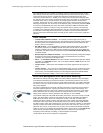
Combining high-performance architecture with high-performance Xeon processors
Please see the Legal Information section for important notices and information.
5
High-Speed Scalability Ports
When more than one chassis is used, they are simply cabled together via one or more
scalability cables. Up to three cables connected to low-latency, 10.24Gbps full-duplex ports
(5.12Gbps in each direction), supported by up to 1GB of L4 cache, provide exceptional
interchassis throughput (30.72Gbps aggregate). Because of this design, an x3950 M2 server
has the incredible flexibility of starting out as a 4-socket server with up to 256GB of memory,
256MB of L4 cache, seven PCIe adapter slots, and four HDD bays, and then doubling, tripling,
or even quadrupling those numbers while maintaining first-in-class performance.
This feature is another unique IBM enhancement, not offered by other x86 server architectures.
DDR II ECC Memory with Active Memory Protection
The eX4 servers support up to 256GB of memory per node (chassis) in 32 DIMM sockets (up to
1TB for a 4-node/16-processor configuration). It uses PC5300 double data rate II (DDR II)
memory (operating at 533MHz) for faster access, and provides IBM Active Memory features,
including advanced IBM Chipkill memory protection, for up to 16X better error correction than
standard ECC memory, IBM Memory ProteXion, hot-add/hot-swap memory support, and
optional memory mirroring. (Notes: Hot-add capability requires operating system support. Hot-
add memory and mirroring are mutually exclusive. Conversely, hot-swap requires mirroring.)
The standard configuration includes two memory cards, which support up to eight DIMMs
apiece. The system is upgradeable to four memory cards with eight DIMMs each. With
configurations of 8-to-16 DIMMs, using two memory cards saves cost, but using four cards
increases performance. (With more than 16 DIMMs, four memory cards are required.)
The memory architecture of the eX4 chipset provides up to 60% more aggregate memory
bandwidth (up to 34.1GBps when using four memory cards vs. a maximum of 21.3GBps
bandwidth in the previous generation), for exceptional memory performance, and quadruple the
system memory capacity of the predecessor x3850 server. By performing reads and writes
simultaneously, it eliminates the previous memory read-to-write blocking latency. In addition, it
also offers innovative data reliability and security features to help improve data integrity,
including enhanced CRC protection, data retry on error detect and buffer registers for improved
fault isolation. Even running at 533Mhz, with twice the number of channels and twice the DIMM
capacity supported, the x3850 M2 and x3950 M2 deliver a memory subsystem with greater
throughput than the competition. In addition, the DDR2 DIMMs use up to 37% less energy than
the competition’s FB-DIMMs.
Memory scrubbing is an automatic daily test of all system memory. It detects and reports
memory errors that might be developing before they cause a server outage. Memory scrubbing
and Memory ProteXion work together. When a bit error is detected, memory scrubbing
determines whether the error is recoverable. If the error is recoverable Memory ProteXion
technology will write the data to new location; if it is not recoverable, scrubbing sends an alert to
light path diagnostics, which then notifies IBM Systems Director.
Memory ProteXion
technology (also called redundant bit steering) provides multichip error
protection and works in conjunction with Chipkill technology—which provides multibit protection
per chip—and standard ECC protection, to provide three-level memory correction. For increased
availability, the eX4 design offers an additional level of Active Memory protection: memory
mirroring.
Memory mirroring works much like disk mirroring. The total memory is divided into two
channels. Data is written concurrently to both channels. If a DIMM fails in one of the DIMMs in
the primary channel, it is instantly disabled and the mirrored (backup) memory in the other
channel becomes active (primary) until the failing DIMM is replaced. Note: Mirroring requires
DIMMs to be installed in multiples of four (one pair per memory channel).
A secondary benefit of memory mirroring is that the failed DIMM and its memory card can be
hot-swapped out to replace the failed DIMM. This is a hardware feature that is operating system
independent.
DIMMs must be installed in matching pairs. Memory is available in kits consisting of two 1GB,
2GB, 4GB or 8GB DIMMs.
Flexible Internal Storage Capacity
The eX4 servers offer a choice of internal storage, supporting up to four (2.5-inch) hot-swap
high-performance Serial-Attach SCSI (SAS) drives per chassis. In addition, selected models of
the x3850 M2 include an integrated 4GB USB 2.0 Flash Key with VMware preloaded as an
embedded virtualization hypervisor.


















